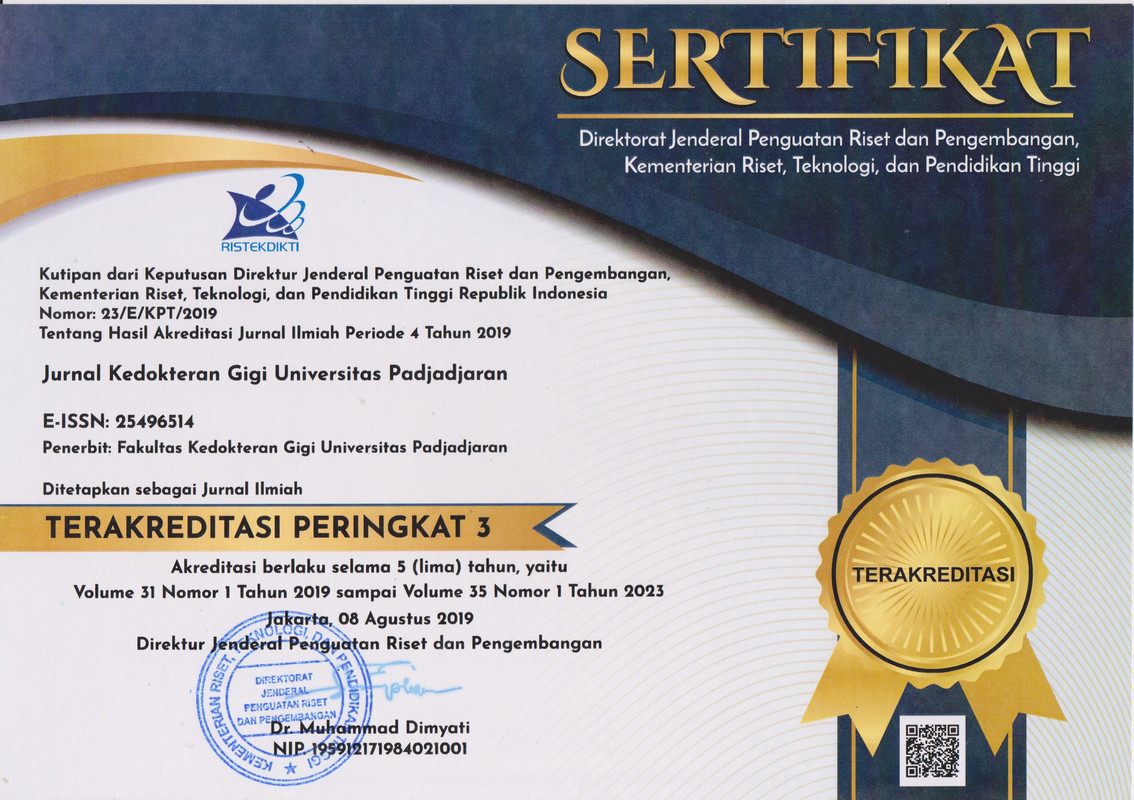Korelasi antara profil darah lengkap dengan waktu penyembuhan Recurrent Aphthous Stomatitis: observasional analitik
Abstract
The correlation between complete blood profile and healing time of Recurrent Aphthous Stomatitis: analytical observational
Introduction: Recurrent Aphthous Stomatitis (RAS) is one of the most common oral mucosa diseases. RAS occurs with various predisposing factors, accompanied by pain, and has varying healing times. A complete blood count is a blood test that measures several blood components, including red blood cells, white blood cells, hemoglobin, hematocrit, and platelets. Among the etiological factors of RAS, inflammatory factors are known to play a role. In theory, it is known that neutrophils and lymphocytes are responsible for inflammation. Methods: This study is an observational analytical study with a cross-sectional design. The sampling method in this study is total sampling. This study used 20 patients who were experiencing RAS. Patient data has been obtained from the medical records of RSGM Universitas Airlangga. The data is complete, including patient blood tests and RAS healing time. Data from both variables were analyzed using statistical correlation tests. Pearson correlation is used when the data is normally distributed, while Spearman's Rho is used when the data is not normally distributed. Results: The results of the Pearson correlation test between lymphocytes and RAS healing time with a value of r = -0,459; p = 0,042 showed a negative correlation value, meaning that the higher the lymphocyte levels, the lower the RAS healing time. Lymphocytes, platelets, eosinophils, and LED also showed negative correlation values but were not significant because p>0,05. No significant values were found in other variables except lymphocytes and MCHC. Conclusion: a correlation exists between complete blood profile (lymphocytes and MCHC) and RAS healing time.
Keywords
Full Text:
PDFReferences
Thantawi A, Khairiati, Nova MM, Marlisa S, Bakar A. Stomatitis Apthosa Rekuren (SAR) minor multiple pre menstruasi (laporan kasus). Odonto Dent J 2014;1( Issue 2):57-62. https://doi.org/10.30659/odj.1.2.57-62
Dewi AGP, Herawati E, Wahyuni IS. Penilaian faktor predisposisi recurrent aphthous stomatitis dengan menggunakan Kessler psychological distress scale, food recall, dan food frequency questionnaire. J Ked Gi Univ Padj. 2017;29(3):168-72. https://doi.org/10.24198/jkg.v29i3.15941
Glick, M. Burket’s Oral Medicine. 12th ed, USA: People’s Medical Publishing House. 2015. p. 173-175
Queiroz SIML, da Silva MVA, de Medeiros AMC, de Oliveira PT, Gurgel BC de V, da Silveira ÉJD. Recurrent aphthous ulceration: An epidemiological study of etiological factors, treatment and differential diagnosis. An Bras Dermatol. 2018 May 1;93(3):341–6. DOI: http://dx.doi.org/10.1590/abd1806-4841.20186228
Aswad, Fatima Ghazi. Recurrent aphthous ulceration prevalence and the factors associated with it among dentistry students tikrit University. Indo J Health Scie Medic. 2024);1(2):1-15. https://doi.org/10.21070/ijhsm.v1i2.29
Kementrian Kesehatan. Laporan Nasional Riskesdas 2018. Jakarta; 2018. h. 181-7.
Tarakji B, Gazal G, Ali Al-Maweri S, Nasser Azzeghaiby S, Alaizari N. Guideline for the diagnosis and treatment of recurrent aphthous stomatitis for dental practitioners. J Int Oral Health. 2015 May;7(5):74–80.
Cui, RZ, Bruce AJ, Rogers RS. Recurrent aphthous stomatitis. Clin Dermatol. 2016 Jul 1;34(4):475–81. http://dx.doi.org/10.1016/j.clindermatol.2016.02.020
Sulistiani A, Hernawati S, Ayu MP. Prevalensi dan distribusi penderita stomatitis aftosa rekuren (SAR) di Klinik Penyakit Mulut RSGM FKG Universitas Jember pada Tahun 2014. e-J Pustaka Kes 2017;5(1):169-76.
Challacombe SJ, Alsahaf S, Tappuni A. Recurrent aphthous stomatitis: towards evidence-based treatment? in current oral health reports. Springer Scie Business Media B.V. 2015;2(Issue 3):158-67. https://doi.org/10.1007/s40496-015-0054-y
Afifah M, Herawati E, Hidayat W. Predisposing factors of minor recurrent aphthous stomatitis in patients at Rumah Sakit Gigi Dan Mulut Fkg Unpad. Padj J Dent Res Stud 2022;6(3):282-9. https://doi.org/10.24198/pjdrs.v6i3.33554
Fdil N. Blood Physiology and its Functions. J Contempor Medic Educat 2022;12(Issue 7).
Agnello L, Giglio RV, Bivona G, Scazzone C, Gambino CM, Iacona A, et al. The value of a complete blood count (Cbc) for sepsis diagnosis and prognosis. Diagnostics(Basel) 2021;11(10):1881. https://doi.org/10.3390/diagnostics11101881
Gonzalez AC, Costa TF, Andrade ZA, Medrado AR. Wound healing - A literature review. Anais Brasileiros de Dermatologia. Sociedade Brasileira de Dermatologia; 2016. p. 614–20. DOI: http://dx.doi.org/10.1590/abd1806-4841.20164741
Wallace HA, Basehore BM, Zito PM. Wound Healing Phases. Treasure Island (FL): StatPearls Publishing; 2019 Jan-Aug
Yip WL. Influence of oxygen on wound healing. Int Wound J. 2015 Dec;12(6):620-4. https://doi.org/10.1111/iwj.12324
Priambodo NT, Hendarti HT, Kharimah A. Multidisciplinary Management of Recurrent Aphthous Stomatitis Triggered by Severe Depression. Denta J Ked Gi. 2021;15(1):39–44. https://doi.org/10.30649/denta.v15i1
Litvinov RI, Weisel JW. Role of red blood cells in haemostasis and thrombosis. ISBT Sci Ser 2017;12(1):176-83. https://doi.org/10.1111/voxs.12331
Mustafa BE, Kashmoola MA, Mustafa NS, Al-Ani IM. Assessment of Haemoglobin Level in Patient with Recurrent Oral Ulcer of a Sample of Malaysian Population. RRJMHS. 2015;4(4):9-12.
Sun A, Chen HM, Cheng SJ, Wang YP, Chang JYF, Wu YC, et al. Significant association of deficiency of hemoglobin, iron, vitamin B12, and folic acid and high homocysteine level with recurrent aphthous stomatitis. J Oral Pathol Med. 2015;44:300-5. https://doi.org/10.1111/jop.12241
Bao ZX, Shi J, Yang XW, Liu LX. Hematinic deficiencies in patients with recurrent aphthous stomatitis: Variations by gender and age. Medicina Oral Patologia Oral y Cirugia Bucal. 2018;23(2):e161-7. https://doi.org/10.4317/medoral.21885
Aslam M, Bashir A, Abbas Z, Saad Ul Hassan M, Afridi A, Abbas Zaidi SA. Importance of iron deficiency in patients with recurrent aphthous stomatitis. Pakistan BioMedical J. 2022;85–88. http://dx.doi.org/10.54393/pbmj.v5i6.528
Wu YC, Wu YH, Wang YP, Chang JYF, Chen HM, Sun A. Hematinic deficiencies and anemia statuses in recurrent aphthous stomatitis patients with or without atrophic glossitis. J Formosan Medic Assoc. 2016;115(12):1061–1068. https://doi.org/10.1016/j.jfma.2016.10.007
DOI: https://doi.org/10.24198/jkg.v37i2.61016
Refbacks
- There are currently no refbacks.
Copyright (c) 2025 Jurnal Kedokteran Gigi Universitas Padjadjaran
INDEXING & PARTNERSHIP

Jurnal Kedokteran Gigi Universitas Padjadjaran dilisensikan di bawah Creative Commons Attribution 4.0 International License






.png)

















